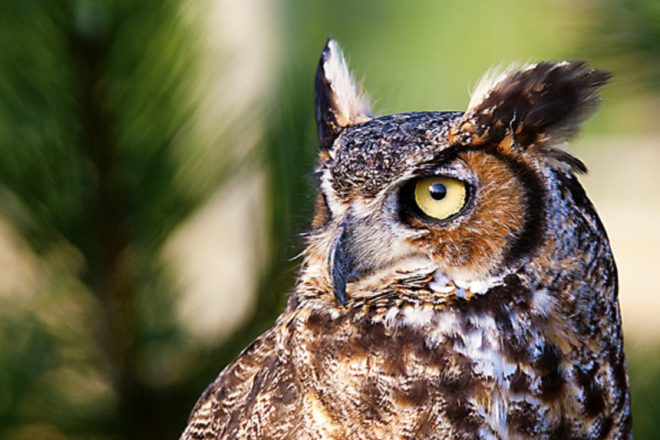The great horned owl (Bubo virginianus) is a ubiquitous and formidable predator, gracing the skies of North and South America. This avian apex predator, recognizable by its prominent ear tufts and piercing yellow eyes, holds a significant place in both ecological balance and human culture. Delving into the specifics of its biology, behavior, and conservation status reveals a complex and fascinating creature.
Taxonomy and Distribution
The great horned owl belongs to the family Strigidae, a diverse group of nocturnal raptors. Several subspecies exist, varying in size and coloration depending on geographical location. These owls occupy a vast range, from the boreal forests of Canada to the tropical rainforests of South America. Their adaptability allows them to thrive in diverse habitats, including woodlands, deserts, grasslands, and even suburban areas. This extensive range contributes to their relatively stable population status.
Physical Characteristics
The great horned owl is a large and powerfully built bird, typically measuring between 18 and 25 inches in length, with a wingspan ranging from 3 to 5 feet. Females are generally larger than males, a common trait among raptors. Their plumage is a mottled mix of brown, gray, black, and white, providing excellent camouflage against tree bark and foliage. The eponymous “horns” are, in fact, feather tufts that serve a display purpose, enhancing their visual communication. The facial disc, a concave arrangement of feathers around the eyes, functions as a parabolic reflector, channeling sound waves to the ears and enhancing their auditory acuity.
Hunting and Diet
Great horned owls are opportunistic predators with a broad diet. They are primarily nocturnal hunters, employing a sit-and-wait strategy or silently gliding through the undergrowth to ambush their prey. Their keen eyesight and exceptional hearing enable them to locate prey in low-light conditions. The list of potential prey is extensive and includes mammals (rodents, rabbits, squirrels, and even skunks), birds (ducks, geese, and other owls), reptiles, amphibians, fish, and invertebrates. They are known to occasionally take larger prey, such as domestic cats or even small deer fawns. Pellets, regurgitated masses of indigestible material like bones, fur, and feathers, provide valuable insights into their dietary habits.
Vocalization and Communication
The great horned owl possesses a diverse repertoire of vocalizations. The most recognizable is the deep, resonant hooting, typically a series of 4-5 hoots, used for territorial defense and mate attraction. Individuals have slightly different vocal signatures allowing for recognition. Other calls include screeches, barks, and hisses, used in aggressive encounters or during courtship displays. Juvenile owls emit a piercing screeching call to solicit food from their parents. Vocal communication plays a crucial role in maintaining pair bonds and establishing dominance within a given territory.
Reproduction and Life Cycle
Great horned owls are monogamous and often mate for life. Breeding season typically begins in late winter or early spring, with nesting occurring in abandoned nests of other large birds, tree cavities, or even rock ledges. They do not build their own nests. The female lays 1-4 eggs, which she incubates for approximately 30-37 days. During this time, the male provides her with food. After hatching, the young owlets are altricial, meaning they are dependent on their parents for care. The parents diligently feed and protect their offspring until they fledge, or leave the nest, at around 6-7 weeks of age. Juvenile owls remain dependent on their parents for several months, learning essential hunting skills before dispersing to establish their own territories. The lifespan of a great horned owl in the wild is typically 10-15 years, although they can live longer in captivity.
Ecological Role and Conservation Status
As apex predators, great horned owls play a crucial role in regulating populations of their prey species. Their presence helps to maintain biodiversity and prevent imbalances within ecosystems. They are particularly important in controlling rodent populations, thus benefiting agriculture and reducing the spread of certain diseases. The great horned owl is currently classified as a species of “Least Concern” by the International Union for Conservation of Nature (IUCN). However, they face several threats, including habitat loss, pesticide poisoning (particularly through secondary consumption of poisoned rodents), and collisions with vehicles and power lines. Conservation efforts focus on habitat preservation, reducing pesticide use, and mitigating human-related hazards.
Cultural Significance
The great horned owl holds a prominent place in the mythology and folklore of many Native American cultures. In some traditions, it is seen as a symbol of wisdom and knowledge, while in others, it is associated with darkness and death. Its powerful presence and nocturnal habits have contributed to its mystique and symbolic significance across diverse cultures. Even in contemporary society, the great horned owl continues to fascinate and inspire awe, serving as a reminder of the power and beauty of the natural world.
Observing Great Horned Owls
While observing great horned owls in their natural habitat can be a rewarding experience, it is important to do so responsibly and ethically. Respect their space and avoid disturbing them, especially during nesting season. Look for signs of their presence, such as pellets or whitewash (droppings) beneath roosting trees. Listen for their characteristic hooting calls, particularly during dawn and dusk. Using binoculars or a spotting scope can enhance your viewing experience. Remember to minimize your impact on the environment and avoid using flash photography, which can disturb the owls. Joining organized birdwatching tours or contacting local wildlife organizations can provide valuable insights and ensure responsible observation practices.
